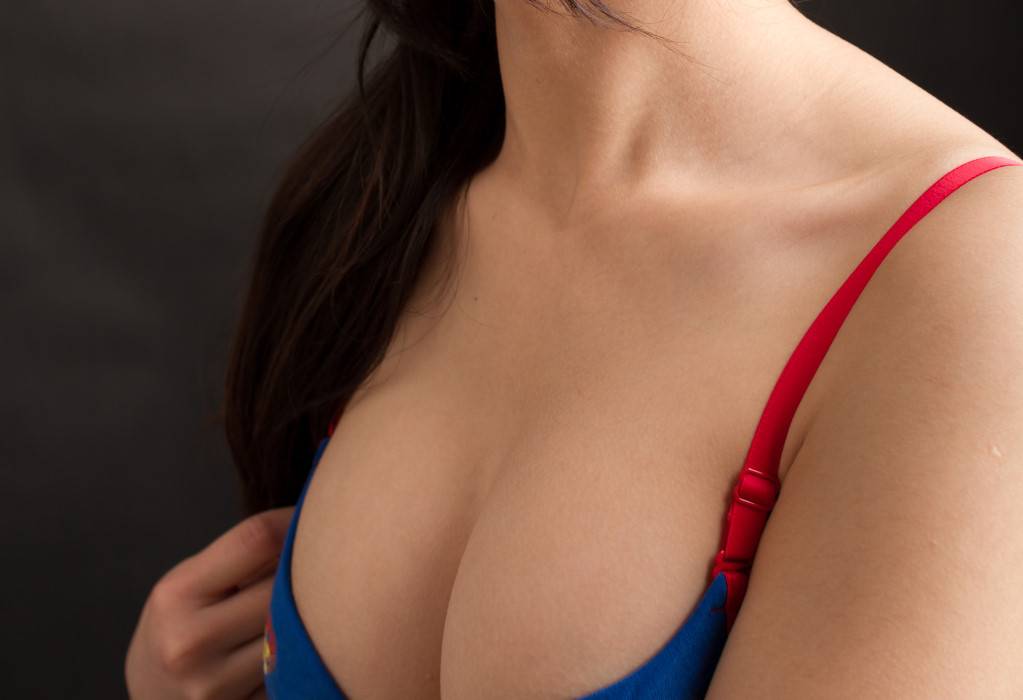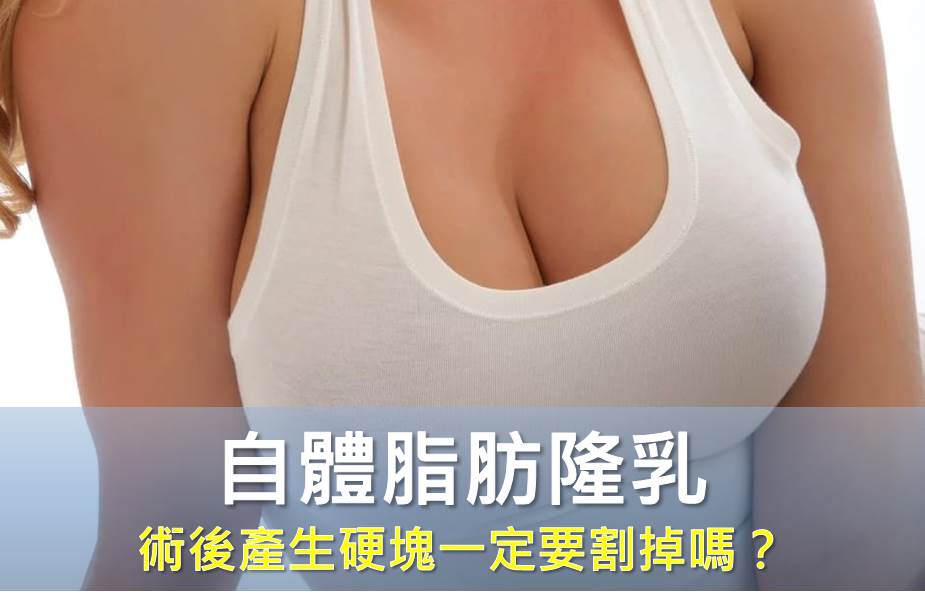自體脂肪隆乳有很多有優點,包括隆乳後的胸部自然柔軟,可以有深邃的乳溝,北半球有自然的起飛線,如果不說的話第一次認識妳的人會以為這就是妳原來的胸部,完全不知道你動過手術。

歡迎轉載,請註明出處。
自體脂肪隆乳有很多有優點,但是也存在一些風險
另外一個優點也很吸引人,那就是「搬有運無」,做自體脂肪隆乳的同時還可以順便做體型雕塑,原先瘦不掉的地方,像是瘦腿、大腿、小腹、腰部、手臂等等,甚至小腿都可以一次變纖細。1,2
但是,自體隆乳跟其他美容手術一樣,也存在一些風險。國外的統計,自體脂肪豐胸之後產生併發症的比例,大約在17%左右。這些併發症包括胸部的硬塊、脂肪囊腫、感染…等問題。日本知名的整形外科教授做出來的結果,40個自體脂肪的案例術後產生硬塊的也高達4例,也就是10%。3,4
2016年著名的「美容外科醫學期刊」(Aesthetic Surgery Journal) 一篇系統回顧的文章,綜合資料顯示自體脂肪隆乳的風險跟傳統「假體隆乳」的風險差不多,假體隆乳的風險包括:莢膜攣縮、假體破裂、手術感染、外觀變形不自然…等等。可以說,沒有誰是必然的優勝。4
以癌症的風險和患者的滿意度來說,自體脂肪隆乳略勝一籌
但是說到癌症的風險和患者的滿意度,自體豐胸就略勝一籌了。依照目前的大規模分析來看,自體脂肪隆乳後乳癌的風險和正常女性差不多,並沒有因為自體脂肪隆乳而增加女性得乳癌的風險;但是假體隆乳跟癌症的相關性,目前的報告正反兩面都有。國外有越來越多懷疑假體隆乳和某種淋巴癌(Anaplastic Large Cell Lymphoma, ALCL)相關的報導。5 但是這部分牽涉到很複雜的商業模式,許多報告都欲言又止,讀者請自行判斷。至於病患的滿意度,一年後來看,自體脂肪隆乳後的病患滿意度是佔上風的,較多的患者滿意自體脂肪隆乳後的結果。1-6

自體脂肪隆乳後萬一產生了硬塊,怎麼辦?
自體脂肪隆乳之後是有可能產生硬塊的,這一點任何準備接受自體脂肪隆乳的女性朋友一定要有認知。硬塊產生的原因和注射的技術、脂肪的存活性、本身的血液循環和術後的照顧都有關係。沒有一個醫師希望他的客人術後產生硬塊,每一個醫師也都會盡量提升技術來降低硬塊產生的機率。但是萬一發生了,則要靠客人和醫師共同的努力來解決。1,2
自體脂肪隆乳後在胸部摸到硬塊,有幾種可能性,例如脂肪囊腫(necrotic cyst)、乳腺炎(mastitis) 或纖維硬塊(induration)。不同的硬塊要用不同的方法解決。根據筆者的經驗,經過適當的處理一段時間(幾個月到幾年)之後,硬塊都會慢慢軟化或消失。7
脂肪囊腫 (Fat Necrosis, Cystic Indurations)
脂肪囊腫:脂肪壞死液化後形成的囊腫也稱為「壞死性囊腫」,聽起來很可怕,但卻是最好處理的一種,因為裡面都是液體,所以只要用18號的針頭抽吸就可以消掉,抽吸後在胸部加壓一兩天後就可以了。3-7
乳腺炎 (Inflammatory Mastitis)
乳腺炎:自體脂肪隆乳後,新的脂肪到了乳房裡面,會刺激原來的乳腺造成某種程度的發炎,有的甚至還會在乳房的皮膚上面長一些痘痘,類似青春痘的反應。乳腺發炎會有腫脹變硬的現象,這一點在取出假體後打入自體脂肪的患者特別明顯。假體隆乳(鹽水袋、矽膠隆乳、果凍矽膠、或魔滴隆乳)的女性,因為乳腺受到假體經年累月的擠壓,變得扁平萎縮,胸部的皮膚變薄,胸肌也會有某種程度的萎縮。現在假體取出,這個壓迫的力量消失了,乳腺也會膨脹變鬆,如果又加上自體脂肪的刺激,就會腫漲得很明顯。8,9
有一些取出假體後再打自體脂肪隆乳的患者,打完自體脂肪的三個月胸部已經柔軟了,過了幾個月之後,乳房卻越來越硬,甚至整個乳房都緊繃硬化,有的還會疼痛,這個時候就要懷疑是否有乳腺發炎的可能。特別是在打入的脂肪中加入SVF (Stromal Vascular Fraction) 的更容易出現。10

簡單的鑒別方法是用超音波掃描,如果是脂肪囊腫或纖維硬塊,超音波檢查可以看到反射減少的區域,邊緣規則界線明顯的低反射區,在低反射區的下方會看到正常回音的影像。11
相反的,如果是乳腺炎,則看不到這種圖像,反而是整個胸部都是正常回音的影像,胸部摸起來卻是硬的,這是因為乳腺的回音和旁邊的組織相似的關係。如果做核磁共振造影和細胞穿刺檢查,可以進一步確診。
這種硬塊,只要服用 Bromocriptin 降低乳腺的刺激反應,2-4周之後,乳房就會變軟。
有幾位假體取出後接受自體脂肪隆乳的患者,遇到這種情形很慌張,去找醫院和其他診所的醫師,每個醫師都告訴她沒有辦法,一定要把乳房整個割掉,再裝回假體。這些不吸收新知的醫師把患者嚇哭了,結果,藥物治療一個月後,每個人胸部都開始變軟了。如果聽這些醫師的意見把乳房割掉,那才是後悔莫及。
纖維硬塊 (Firbrotic Induration)
纖維硬塊:這是自體脂肪隆乳後最常見的問題,起因是打進去的脂肪得不到血流提供的氧氣和養分而壞掉,慢慢被纖維組織取代而形成的。嚴格講起來這也沒什麼問題,跟乳癌無關,不用擔心,但是因為摸得到,患者本人或親密伴侶的心理會有障礙,所以通常客人會希望讓硬塊軟化或消掉。

處理的辦法我在別的文章中討論過,目前文獻發表過的方法有:細針穿刺和超音波溶脂兩種,都可以有效處理硬塊問題。但是超音波溶脂屬於侵入性的處理,如果不希望術後瘀青腫脹,可改採較微創的方式:軟化針注射。軟化針注射可以使脂肪形成的硬塊軟化,軟化針的成分是一種類固醇Triamcenolone。大面積的硬塊要用稀釋的 Triamcenolone,先從少量開始注射,等候兩個月,不夠的話可以再注射。軟化針注射可能會使乳房體積變小,注射時宜避免淺層注射以免皮膚凹陷,這一點要先跟客人說清楚。
手術切除是除去乳房硬塊最有效的方法,但是無法避免會留下疤痕和外觀的改變。如果前述方法都不能除去纖維硬塊的話,可以考慮手術切除。
目前由於診斷技術已經相當進步,自體脂肪隆乳後產生的硬塊可以和乳癌分辨,加上細針穿刺的確診,若屬於纖維組織或乳腺發炎組織,分期在 BIRADS 3 以下,定期追蹤觀察即可。只要跟客人解釋清楚,不一定要切除。7, 12
結論:
一、自體脂肪隆乳後乳房的硬塊不一定要切除,堅持切除才能處理的醫師是觀念老舊的醫師。
二、自體脂肪隆乳後產生硬塊或乳房變硬,要先做相關的檢查,超音波和核磁共振造影可以分辨脂肪形成的硬塊、乳腺炎或是乳癌病變,有必要的時候可做乳房穿刺細胞學檢查。
三、排除乳癌的可能性之後,可採用本文建議的方法,讓硬塊軟化或消除。
四、假體取出後的自體脂肪隆乳,有較高的乳腺炎發生機率,乳腺炎會使乳房整個變硬。口服乳腺抑制藥物可以讓乳房軟化。
五、自體脂肪隆乳是安全的隆乳手術,滿意度很高。但還是有可能發生併發症,只要配合醫師好好處理,一般都可以解決的。
參考文獻:
- Chiu CH. Autologous Fat Grafting for Breast Augmentation in Underweight Women. Aesth Surg J. 2014 Sep;34(7):1066-82.
- Chiu CH. A “Solid Injection Method” To Reduce Postoperative Complications in Autologous Fat Grafting for Breast Augmentation. American Journal of Cosmetic Surgery: March 2013, Vol. 30, No. 1, pp. 10-15.
- Groen JW, Negenborn VL, Twisk DJ, Rizopoulos D, Ket JC, Smit JM, Mullender MG. Autologous fat grafting in oncoplastic breast reconstruction: A systematic review on oncological and radiological safety, complications, volume retention and patient/surgeon satisfaction. J Plast Reconstr Aesthet Surg. 2016 Jun;69(6):742-64.
- Yoshimura K, Sato K, Aoi N, Kurita M, Hirohi T, Harii K. Cell-assisted lipotransfer for cosmetic breast augmentation: supportive use of adipose-derived stem/stromal cells. Aesthetic Plast Surg. 2008 Jan;32(1):48-55;
- Gidengil CA, Predmore Z, Mattke S, van Busum K, Kim B. Breast implant-associated anaplastic large cell lymphoma: a systematic review. Plast Reconstr Surg. 2015 Mar;135(3):713-20.
- Groen JW, Negenborn VL, Twisk JW, Ket JC, Mullender MG, Smit JM. Autologous Fat Grafting in Cosmetic Breast Augmentation: A Systematic Review on Radiological Safety, Complications, Volume Retention, and Patient/Surgeon Satisfaction. Aesthet Surg J. 2016 Oct;36(9):993-1007.
- Jandali S, Bucky LP. A simplified technique for the management of fat necrosis in autologous breast reconstruction. J Plast Reconstr Aesthet Surg. 2011 Jun;64(6):831-3.
- Walden PD, Ruan W, Feldman M, Kleinberg DL. Evidence that the mammary fat pad mediates the action of growth hormone in mammary gland development. Endocrinology. 1998 Feb;139(2):659-62.
- Mallepell S1, Krust A, Chambon P, Brisken C. Paracrine signaling through the epithelial estrogen receptor alpha is required for proliferation and morphogenesis in the mammary gland. Proc Natl Acad Sci U S A. 2006 Feb 14;103(7):2196-201
- Chiu CH. Autologous Fat Grafting for Breast Augmentation in Patients After Implant Removal. The American Journal of Cosmetic Surgery Vol. 32, No. 3, 2015
- Helmut Madjar, Ellen B. Mendelson. The practice of breast ultrasound: techniques, findings, differential diagnosis. 2nd. ed. Theme, New York. 2008
- Caterson SA1, Tobias AM, Slavin SA, Lee BT. Ultrasound-assisted liposuction as a treatment of fat necrosis after deep inferior epigastric perforator flap breast reconstruction: a case report. Ann Plast Surg. 2008 Jun;60(6):614-7.
Is Excision the Only Way to Manage Indurations After Fat Grafting for Breast Augmentation?
Cheng-Hung Chiu, M.D. Chief, Plastic and Aesthetic Department Genesis Clinic No. 93-1, Xinglong Rd. Sec. 2, Taipei, TAIWAN E-mail: chiuokclinic@gmail.com
The advantages of autologous fat grafting for breast augmentation are as follows: natural contour and soft consistence of the breasts, deep cleavage, and visually pleasing north-pole. If the client doesn’t say, her partner can’t tell if her breasts are real or not. Besides, simultaneous body sculpturing is an attractive benefit of this procedure. We can perform cosmetic breast augmentation and reduction of local fat deposition at the same time. The so called ‘resistant fat accumulation’ at thighs, abdomen, flank, upper arms and calves can be removed after this operation. 1,2
However, autologous fat grafting for breast augmentation, like other breast surgeries, is not without risks. According to published literatures, complication rate after this operation is around 17% including infection, fat necrosis, and indurations. Even when auxiliary procedure of cell-assisted lipotransfer (CAL) is undertaken, the complication rate is 10%. 3,4
In 2016, a systemic review published in Aesthetic Surgery Journal concluded that the risk of autologous fat grafting for breast augmentation was not higher than traditional implant breast augmentation. The complications of implant breast augmentation include capsular contracture, implant rupture, surgical infection and unnatural appearance… etc. No one is bound to be better. 4
As for the risk of cancer occurrence and patient satisfaction, it seems like autologous fat grafting for breast augmentation is superior to implant breast augmentation. Studies show that the oncological risk is not higher in patients undergoing fat grafting either for cosmetic augmentation or post-mastectomy reconstruction. On the other hand, more and more reports raising the suspected association between implants and anaplastic large cell lymphoma (ALCL) have been introduced. 5 Patient’s satisfaction at one year follow up in those receiving fat grafting for breast augmentation is higher than implant breast augmentation.1-6
What if complications develop after autologous fat grafting for breast augmentation?
Complications, especially indurations could occur after this operation. Patients who are ready for undergoing this procedure must acknowledge this fact. The causes of indurations are related to injection technique, adipocyte viability, recipient site circulation and patient’s postoperative care. No surgeons are happy about the occurrence of indurations in their patients and they are willing to take every steps to reduce the complications. It needs the doctors and the patients to work together to deal with the complications once happened. 1,2
There are several possibilities, such as necrotic cysts of fat, inflammatory mastitis, and/or fibrotic indurations when the patients notice such hardening in their breasts after autologous fat grafting for breast augmentation. Different strategies are undertaken to deal with different conditions. According to the literatures and the author’s experience, indurations can be softened or disappeared months or years after proper management. 7
Fat Necrosis
Fat necrosis is a relatively minor complication but is one that can cause anxiety in the patients. It’s easy to manage fat necrosis once liquefaction within the mass develops. An eighteen gauge needle mounted to a 5 mL syringe is used to aspirate the liquid. Garment to the breasts is applied for 2 days after this procedure to ensure the disappearance of the cyst. 3-7
Inflammatory Mastitis
After autologous fat grafting to the breasts, the paracrine of the transplanted adipose tissue can stimulate the mammary glands leading to some degree of inflammation. It is not a bacterial infection, though. Some patients even develop acne on the breast skin. The breasts will become hard and painful if inflammation occurs. This is especially prominent in patients receiving fat grafting after implant removal. Patients with long exiting implants in the breasts tend to have compressed mammary glands, thinned skin and atrophic pectoral muscles. After implant removal this pressure is released and the glands become hypertrophic. Under the stimulation of the transplanted fat there can be a certain degree of inflammation inside the glands. 8,9
Patients who underwent fat grafting for breast augmentation after implant removal had soft and natural breasts initially. Several months later some of them develop hardness and even tender in the breasts. This phenomenon arises the suspicion of inflammatory mastitis especially for those receiving stromal vascular fraction (SVF) enriched fat grafting. 10
Ultasonography can be used for differential diagnosis. For fat necrosis or indurations, there are hypoechoic areas of varying size with clear demarcation and posterior acoustic enhancement. 11
On the contrary, inflammatory mastitis reveals an isoechoic area with potential ductal dilatation. Magnetic resonance imaging and aspiration cytology can help in further diagnosis. Bromocriptine mesylate can be used to lower the stimulatory response inside the glands. Usually the breasts will become soft again after 2 to 4 weeks of medical therapy.
Fibrotic Induration
This is the most common complication after autologous fat grafting either in the breasts or the face. The transplanted fat fails to survive if sufficient circulation is not available within the first 2 days after the operation. The necrotic fat is replaced with fibrotic tissue, which is the cause of induration. Seriously speaking, this is a benign lesion not associated with carcinoma and the patient needs not to worry about this. Still, it can create anxiety in the patient and her family.
There are several treatments published in the literatures including needle aeration technique and ultrasound assisted liposuction. Needle aeration is a micro-invasive treatment involving the use of a 18 gauge needle to puncture the mass 30 to 100 times depending on the size of the mass after local anesthesia. Ultrasound assisted liposuction can be done as the usual way to reduce the size of the mass. If the patient dislike either way to help them, injection with Triamcenolone can be beneficial in softening the mass. Starting from low concentration, the procedure can be repeated 2 months after previous injection. Care should be taken not to inject too superficially in order to avoid surface depression. Inform the patient that the breast size could be smaller after this treatment.
Excision is the final and most effective way to treat it and will inevitably result in scar on the skin and potential contour change. However, this is the final resort since fat graft induration can be easily differentiated from malignant lesion by experienced radiologist. Regular follow-up for the cases with BIRADS 3 or under is the best way to manage this complication. 7,12
Conclusions
- Excision of the induration after autologous fat grafting for breast augmentation is not a must.
- Differential diagnosis is the first step to take.
- After exclusion of malignant lesion, the surgeon can manage fribrotic induration by using the aforementioned strategies.
- Patients with long existing breast implants have greater chance to develop inflammatory mastitis after they undergo implant removal and fat grafting to re-contour their breasts.
- In the end, autologous fat grafting is a safe breast augmentation procedure with high patient satisfaction. However, complication can develop and is best managed with the cooperation of the doctor and the patient.
References
- Chiu CH. Autologous Fat Grafting for Breast Augmentation in Underweight Women. Aesth Surg J. 2014 Sep;34(7):1066-82.
- Chiu CH. A “Solid Injection Method” To Reduce Postoperative Complications in Autologous Fat Grafting for Breast Augmentation. American Journal of Cosmetic Surgery: March 2013, Vol. 30, No. 1, pp. 10-15.
- Groen JW, Negenborn VL, Twisk DJ, Rizopoulos D, Ket JC, Smit JM, Mullender MG. Autologous fat grafting in oncoplastic breast reconstruction: A systematic review on oncological and radiological safety, complications, volume retention and patient/surgeon satisfaction. J Plast Reconstr Aesthet Surg. 2016 Jun;69(6):742-64.
- Yoshimura K, Sato K, Aoi N, Kurita M, Hirohi T, Harii K. Cell-assisted lipotransfer for cosmetic breast augmentation: supportive use of adipose-derived stem/stromal cells. Aesthetic Plast Surg. 2008 Jan;32(1):48-55;
- Gidengil CA, Predmore Z, Mattke S, van Busum K, Kim B. Breast implant-associated anaplastic large cell lymphoma: a systematic review. Plast Reconstr Surg. 2015 Mar;135(3):713-20.
- Groen JW, Negenborn VL, Twisk JW, Ket JC, Mullender MG, Smit JM. Autologous Fat Grafting in Cosmetic Breast Augmentation: A Systematic Review on Radiological Safety, Complications, Volume Retention, and Patient/Surgeon Satisfaction. Aesthet Surg J. 2016 Oct;36(9):993-1007.
- Jandali S, Bucky LP. A simplified technique for the management of fat necrosis in autologous breast reconstruction. J Plast Reconstr Aesthet Surg. 2011 Jun;64(6):831-3.
- Walden PD, Ruan W, Feldman M, Kleinberg DL. Evidence that the mammary fat pad mediates the action of growth hormone in mammary gland development. Endocrinology. 1998 Feb;139(2):659-62.
- Mallepell S1, Krust A, Chambon P, Brisken C. Paracrine signaling through the epithelial estrogen receptor alpha is required for proliferation and morphogenesis in the mammary gland. Proc Natl Acad Sci U S A. 2006 Feb 14;103(7):2196-201
- Chiu CH. Autologous Fat Grafting for Breast Augmentation in Patients After Implant Removal. The American Journal of Cosmetic Surgery Vol. 32, No. 3, 2015
- Helmut Madjar, Ellen B. Mendelson. The practice of breast ultrasound: techniques, findings, differential diagnosis. 2nd. ed. Theme, New York. 2008
- Caterson SA1, Tobias AM, Slavin SA, Lee BT. Ultrasound-assisted liposuction as a treatment of fat necrosis after deep inferior epigastric perforator flap breast reconstruction: a case report. Ann Plast Surg. 2008 Jun;60(6):614-7.

